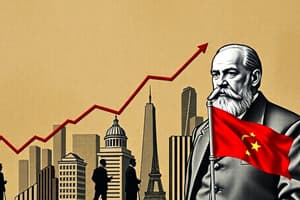Podcast
Questions and Answers
Which of the following indicators are NOT included in the World Bank's preliminary set of indicators for measuring basic needs?
Which of the following indicators are NOT included in the World Bank's preliminary set of indicators for measuring basic needs?
- Education
- Housing
- Food
- Transportation (correct)
High basic-needs attainment is negatively correlated with the rate of growth of per capita GNP.
High basic-needs attainment is negatively correlated with the rate of growth of per capita GNP.
False (B)
What is an important indicator of the availability of sanitation and clean water facilities?
What is an important indicator of the availability of sanitation and clean water facilities?
Infant mortality
The text highlights that GNP per head remains an important figure, but it also emphasizes the need to consider ______ and ______ of GNP.
The text highlights that GNP per head remains an important figure, but it also emphasizes the need to consider ______ and ______ of GNP.
Which concept do some economists believe is necessary to measure economic development effectively?
Which concept do some economists believe is necessary to measure economic development effectively?
Economic development is solely defined by the growth of per capita income.
Economic development is solely defined by the growth of per capita income.
What do economists like Coline Clark and Kindleberger suggest as a measure of economic development?
What do economists like Coline Clark and Kindleberger suggest as a measure of economic development?
____ is a measure of economic development that focuses on purchasing power and income distribution.
____ is a measure of economic development that focuses on purchasing power and income distribution.
Which of the following factors is NOT mentioned as important for increasing economic welfare?
Which of the following factors is NOT mentioned as important for increasing economic welfare?
Match the following economists with their views on economic development:
Match the following economists with their views on economic development:
Economic development can be understood and measured as a comparative concept.
Economic development can be understood and measured as a comparative concept.
According to the content, economic development increases when there is an increase in real per capita income over a ___ period of time.
According to the content, economic development increases when there is an increase in real per capita income over a ___ period of time.
According to the passage, what is one potential consequence of a society's economic growth that is associated with its pursuit of economic progress?
According to the passage, what is one potential consequence of a society's economic growth that is associated with its pursuit of economic progress?
Economic growth can be beneficial to societies by reducing poverty, famine, and infant mortality.
Economic growth can be beneficial to societies by reducing poverty, famine, and infant mortality.
What is one argument presented in the passage for why achieving control over one's environment is a desirable goal?
What is one argument presented in the passage for why achieving control over one's environment is a desirable goal?
The passage suggests that economic growth can lead to a ______ in the extended family system.
The passage suggests that economic growth can lead to a ______ in the extended family system.
Match the following potential costs of economic growth with their corresponding explanations:
Match the following potential costs of economic growth with their corresponding explanations:
Which of the following is NOT mentioned in the passage as a potential benefit of economic growth?
Which of the following is NOT mentioned in the passage as a potential benefit of economic growth?
The passage argues that happiness is the primary goal that economic growth should aim to achieve.
The passage argues that happiness is the primary goal that economic growth should aim to achieve.
Identify one potential negative consequence of economic growth mentioned in the passage.
Identify one potential negative consequence of economic growth mentioned in the passage.
Which sector includes agriculture and fisheries?
Which sector includes agriculture and fisheries?
In developed countries, the majority of the population works in the primary sector.
In developed countries, the majority of the population works in the primary sector.
What is the relationship between economic development and occupational structure according to Colin Clark?
What is the relationship between economic development and occupational structure according to Colin Clark?
The ______ sector consists of manufacturing, trade, and construction.
The ______ sector consists of manufacturing, trade, and construction.
Which of the following is considered a valid indicator of economic development?
Which of the following is considered a valid indicator of economic development?
A heavy dose of taxation can lead to an increase in the standard of living.
A heavy dose of taxation can lead to an increase in the standard of living.
In under-developed countries, most of the working population is engaged in the ______ sector.
In under-developed countries, most of the working population is engaged in the ______ sector.
Match the economic indicator with its correct description:
Match the economic indicator with its correct description:
Which of the following components is NOT included in the calculation of GNP?
Which of the following components is NOT included in the calculation of GNP?
Gross Domestic Product (GDP) includes income earned by residents from overseas investments.
Gross Domestic Product (GDP) includes income earned by residents from overseas investments.
What does net exports represent?
What does net exports represent?
Gross National Product (GNP) is concerned with the value of all finished goods and services owned by a country's __________.
Gross National Product (GNP) is concerned with the value of all finished goods and services owned by a country's __________.
What are basic needs according to the basic-needs approach?
What are basic needs according to the basic-needs approach?
The basic-needs approach focuses solely on maximizing production levels.
The basic-needs approach focuses solely on maximizing production levels.
According to economists, what must be considered to effectively reduce poverty in developing countries?
According to economists, what must be considered to effectively reduce poverty in developing countries?
Match the following terms with their definitions:
Match the following terms with their definitions:
Which indicator is NOT included in the Human Development Index (HDI)?
Which indicator is NOT included in the Human Development Index (HDI)?
The Physical Quality of Life Index (PQLI) successfully measures total welfare.
The Physical Quality of Life Index (PQLI) successfully measures total welfare.
What year did UNDP first incorporate the Human Development Index (HDI) into its Human Development Report?
What year did UNDP first incorporate the Human Development Index (HDI) into its Human Development Report?
The formula for calculating the Physical Quality of Life Index (PQLI) is PQLI = (IMRI + LEI + BLI) / ______
The formula for calculating the Physical Quality of Life Index (PQLI) is PQLI = (IMRI + LEI + BLI) / ______
Match the following indicators with their definitions:
Match the following indicators with their definitions:
What was the Physical Quality of Life Index (PQLI) for India in 2001?
What was the Physical Quality of Life Index (PQLI) for India in 2001?
According to Morris, what is one limitation of the Physical Quality of Life Index (PQLI)?
According to Morris, what is one limitation of the Physical Quality of Life Index (PQLI)?
Morris sets Gabon's infant mortality rate of 229 per thousand live births as the best rate in 1950.
Morris sets Gabon's infant mortality rate of 229 per thousand live births as the best rate in 1950.
Which of the following indicators is used to measure education?
Which of the following indicators is used to measure education?
High basic-needs attainment is negatively related to the rate of growth of per capita GNP.
High basic-needs attainment is negatively related to the rate of growth of per capita GNP.
What percentage of the population with access to sanitary facilities is considered an important indicator?
What percentage of the population with access to sanitary facilities is considered an important indicator?
Infant mortality is a good indication of the availability of ______ and clean water facilities.
Infant mortality is a good indication of the availability of ______ and clean water facilities.
Match the following economic concepts with their descriptions:
Match the following economic concepts with their descriptions:
Which socioeconomic right is included in the U.N. Universal Declaration of Human Rights?
Which socioeconomic right is included in the U.N. Universal Declaration of Human Rights?
The satisfaction of basic needs is considered a human right according to the U.S. Founders.
The satisfaction of basic needs is considered a human right according to the U.S. Founders.
Name one factor that is positively associated with increased worker health and productivity.
Name one factor that is positively associated with increased worker health and productivity.
Flashcards
Economic Development Comparison
Economic Development Comparison
Two methods to compare economic development over time: within a country and with other countries.
Occupational Structure
Occupational Structure
The distribution of the working population across different sectors which impacts economic development.
Primary Sector
Primary Sector
The economic sector involving agriculture, forestry, mining, etc., commonly dominant in under-developed countries.
Secondary Sector
Secondary Sector
Signup and view all the flashcards
Tertiary Sector
Tertiary Sector
Signup and view all the flashcards
Shifts in Occupational Distribution
Shifts in Occupational Distribution
Signup and view all the flashcards
Standard of Living Criterion
Standard of Living Criterion
Signup and view all the flashcards
Consumption Level
Consumption Level
Signup and view all the flashcards
Total Income
Total Income
Signup and view all the flashcards
Per Capita Real Income
Per Capita Real Income
Signup and view all the flashcards
Economic Welfare
Economic Welfare
Signup and view all the flashcards
Economic Development
Economic Development
Signup and view all the flashcards
Factors Influencing Economic Welfare
Factors Influencing Economic Welfare
Signup and view all the flashcards
Comparative Concept of Development
Comparative Concept of Development
Signup and view all the flashcards
Drawbacks of Real National Income
Drawbacks of Real National Income
Signup and view all the flashcards
Economic Growth vs. Economic Development
Economic Growth vs. Economic Development
Signup and view all the flashcards
Life Expectancy
Life Expectancy
Signup and view all the flashcards
Infant Mortality Rate (IMR)
Infant Mortality Rate (IMR)
Signup and view all the flashcards
Physical Quality of Life Index (PQLI)
Physical Quality of Life Index (PQLI)
Signup and view all the flashcards
Range in PQLI
Range in PQLI
Signup and view all the flashcards
Human Development Index (HDI)
Human Development Index (HDI)
Signup and view all the flashcards
Limitations of PQLI
Limitations of PQLI
Signup and view all the flashcards
Weighted Indicators
Weighted Indicators
Signup and view all the flashcards
Gabon’s Infant Mortality Rate
Gabon’s Infant Mortality Rate
Signup and view all the flashcards
Calorie Supply
Calorie Supply
Signup and view all the flashcards
Literacy Rates
Literacy Rates
Signup and view all the flashcards
Infant Mortality Rate
Infant Mortality Rate
Signup and view all the flashcards
Access to Sanitation
Access to Sanitation
Signup and view all the flashcards
Basic Needs Theory
Basic Needs Theory
Signup and view all the flashcards
GNP per Head
GNP per Head
Signup and view all the flashcards
Human Rights in Economics
Human Rights in Economics
Signup and view all the flashcards
Gross National Product (GNP)
Gross National Product (GNP)
Signup and view all the flashcards
Gross Domestic Product (GDP)
Gross Domestic Product (GDP)
Signup and view all the flashcards
Net Exports
Net Exports
Signup and view all the flashcards
Basic-Needs Approach
Basic-Needs Approach
Signup and view all the flashcards
Basic Needs Indicators
Basic Needs Indicators
Signup and view all the flashcards
Economic Growth vs. Poverty Reduction
Economic Growth vs. Poverty Reduction
Signup and view all the flashcards
Income Distribution Issues
Income Distribution Issues
Signup and view all the flashcards
Comprehensive Economic Scorecard
Comprehensive Economic Scorecard
Signup and view all the flashcards
Acquisitive Society
Acquisitive Society
Signup and view all the flashcards
Alienation
Alienation
Signup and view all the flashcards
Economic Growth Benefits
Economic Growth Benefits
Signup and view all the flashcards
Individual Control
Individual Control
Signup and view all the flashcards
Costs of Growth
Costs of Growth
Signup and view all the flashcards
Job Specialization
Job Specialization
Signup and view all the flashcards
Bureaucratization
Bureaucratization
Signup and view all the flashcards
Social Tension
Social Tension
Signup and view all the flashcards
Study Notes
Principles and Concepts of Development
- Economic Development: Processes, policies, or activities aiming to improve a community's economic well-being and quality of life.
- Measures of Economic Development: Various methods used to track and assess the progress of economic development, although none is universally accepted.
- National income as an index: Focuses on the total income generated within a country. Net National Product (NNP) is preferred to Gross National Product (GNP) for a better evaluation of progress.
- Per capita real income: Economic progress by increasing aggregate output and the per capita income, as living standards improve.
- Economic welfare: Considers factors like equal income distribution and purchasing power to understand well-being.
- Classification of Rich and Poor Countries: International classification of countries based on their economic standing (e.g., low-income, upper-middle-income, high-income).
- This is primarily based on gross national income (GNI) per capita, determined by the World Bank.
- Basic Needs Attainment: Focus on fulfilling fundamental needs like food, shelter, healthcare, education.
- Growth and Basic Needs: Economic growth correlates with basic needs attainment; increased output leads to better well-being.
- Basic Needs as a Human Right: Economic rights are considered important for a fulfilling life, comparable to civil rights.
- Cost and Benefit of Economic Development: Economic growth brings numerous benefits, but it also has costs like potential social inequality, environmental damage, and shifts in social structures.
Abbreviations
- ASEAN: Association of Southeast Asian Nations
- DCs: Developed countries (high-income)
- E.U.: European Union
- FAO: Food and Agriculture Organization of the United Nations
- G7: Group of Seven countries (major developed economies)
- G8: Group of Eight countries, incorporating Russia
- GATT: General Agreement on Tariffs and Trade (predecessor to WTO)
- GDP: Gross domestic product
- GNI: Gross national income (same as GNP)
- GNP: Gross national product
- HDI: Human Development Index
- ILO: International Labour Organisation
- IMF: International Monetary Fund
- LDCs: Less developed countries (developing nations)
- LICs: Low-income countries
- LLDCs: Least developed countries
- MDGs: Millennium Development Goals
- MNCs: Multinational corporations
- NGOs: Non-governmental organizations
- NICs: Newly industrialising countries
- NNP: Net national product
- OECD: Organisation for Economic Co-operation and Development
- PQLI: Physical Quality of Life Index
- PRI: Partido Revolucionario Institucional (Institutional Revolutionary Party; Mexico)
- UNDP: United Nations Development Programme
- U.N.: United Nations
- UNCTAD: United Nations Conference on Trade and Development.
Other Economic Concepts
- Economic Development: Focused on the broader improvements in the well-being of a nation.
- Economic Growth: Measured by the increase in Gross Domestic Product(GDP).
- Gross Domestic Product: Value of all finished goods and services.
- Gross National Product: Total value of goods and services produced by a countries nation's citizens, regardless of location.
- Classification of Countries: Categorized as Low-income, Lower-Middle-income, Upper-Middle-income , andHigh-income based on their GNI or GDP per capita. These criteria are used to evaluate relative economic well-being.
Human Development Indices
- Physical Quality of Life Index (PQLI): A composite index of factors like infant mortality, life expectancy, and literacy. This is used to measure well-being that extends beyond income, as it combines three key variables.
- Human Development Index (HDI): Combines life expectancy, education, and per capita income to evaluate a country's overall development.
Studying That Suits You
Use AI to generate personalized quizzes and flashcards to suit your learning preferences.




